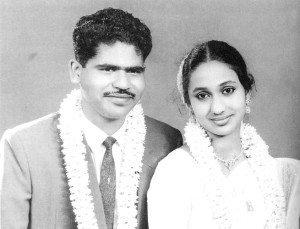Registered with the Registrar of Newspapers for India under R.N.I 53640/91
Vol. XXIX No. 20 , February 1-15, 2020
The Inner Vision gets recognised with a Padmashri
We at Madras Musings are delighted that Manohar Devadoss has been conferred the Padma Shri by the Government of India. We offer our felicitations through this article on him by historian K.R.A. Narasiah.
In her celebrated poem Transcience Sarojini Naidu says,
Nay, do not grieve tho’ life be full of sadness,
Dawn will not veil her splendour for your grief,
Nor spring deny their bright, appointed beauty to lotus blossom and Ashoka leaf.
The indefatigable Mahema-Manohar couple proved the essence of the sentiment expressed in her poem.

The indefatigable Manohar-Mahema.
Manohar was born and raised in Madurai, the city that he loved and continues to admire, and graduated in Chemistry from American College in 1957. His father, fond of music and fine arts, made Mano learn to play the piano, which he was quite good at. However, Mano loved the fine arts and liked to draw. In a meeting in February 2018 at the Madras Literary Society Library, when he was in a near-total-blind condition, it was awesome to watch him make a PowerPoint presentation on his life with a fine touch of humour and an inimitable grace innate to him. He said that he enjoyed drawing pictures from his early childhood, and that the subjects of the art he created kept changing as he grew in years. When he was in the American College, he was struck by the dignity of the brick building in the campus and made a pen and ink drawing of the college Chapel which drew the attention of college authorities as well as the students.
It was then he realised that he had a feel for architectural entities. He says, “I had a good comprehension of perspective and a natural flair for pen and ink drawings.”
After graduating in 1956, he shifted to the then Madras, where he joined a chemical firm that specialized in making electric lamps for miners replacing Davy’s safety lamps. His first art work was a Christmas greeting card that he made for his boss, who was highly impressed. His company sent him to London for three months in 1962 to enhance his technical skills, where on his own he visited museums, listened to western classical music and went around with his English friends. He quipped that the England-returned tag improved his marriage prospects! Back in Madras, he met Mahema, a graduate in fine arts from Stella Maris. The meeting bloomed into genuine love and soon they were married. In 1969, Mano went to Oberlin University in the US to pursue his Masters degree and Mahema joined him. He says that 1970-1972 were the best years of his life. Back in Madras, he continued with his Company and retired as its technical director.

Basking in the company of his old friends: S. Muthiah, Sujatha Shankar, K.R.A. Narasiah and Sriram V.
During early 1960s, Manohar was diagnosed with retinitis pigmentosa, a progressive incurable degenerative eye-condition, which leads to total blindness. Manohar was forced to experience the limits of vision, but this did not lead him to give up his passion. While this was bad enough, worse was yet to happen. On December 30, 1972 – three days after the couple celebrated their ninth wedding anniversary – a road accident turned Mahema into a quadriplegic. Shattered dreams did not suppress the couple’s noble life. As sung by Sarojini Naidu, they accepted what was meted out to them with a rare kind of dignity that saw Mano emerge as writer as well. He would also sketch on the spot while his wife read to him.
His first book was Green Well Years, an autobiographical account and in effect, a tribute to the city he loved the most – Madurai. The book featured festivals in Madurai like Chthirai Thiruvizha etc. Mahema provided the text for his sketches. That was followed by his second book, almost a documentation of Mahema’s life, titled Dreams, Seasons & Promises. Mano went on to publish his third work, A Poem to Courage, a life sketch of Mahema and in 2007 published Multiple Facets of My Madurai, in which every page had a sketch and an explanation by the side.

Above and below: Sketches made by Manohar Devadoss with very minute details.

He published a tribute to Mahema in 2010 titled Mahema and the Butterfly with colourful sketches. The couple spent decades carrying each other’s burdens: Manohar taking care of her physical and emotional needs, despite his progressively failing eyesight and Mahema helping him sketch and paint and write books by being his eyes. It is remarkable that the couple did not allow the debilitating tragedy to spoil their colourful and meaningful life. Until Mahema’s death in March 2008, they made postcards for charity, with Manohar doing the sketches and she providing the text. Their sense of humour and sincerity of purpose in life earned them many admirers and more friends.
His latest work co-authored with architect Sujatha Shankar titled Inked, has 61 sketches by Manohar, including two by his spirited wife Mahema. Descriptions of 42 subjects by Sujatha interspersed with his own notings is to be shortly published. The book narrates the story of the city’s metamorphosis in an evocative manner and Mano seems to freeze time itself with his work.
One is reminded of Vita Sackville-West when she sang:
“The country habit has me by the heart,
For he’s bewitched forever who has seen,
Not with his eyes but with his vision,
Spring flow down the woods and stipple leaves with sun.”

